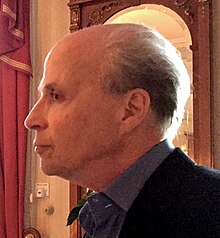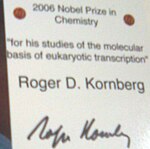Roger David Kornberg(born April 24,[3]1947) is an Americanbiochemistandprofessorofstructural biologyatStanford UniversitySchool of Medicine. Kornberg was awarded theNobel Prize in Chemistryin 2006 for his studies of the process by which genetic information fromDNAis copied toRNA,"the molecular basis ofeukaryotictranscription."[4][5][6][7][8][9]
Roger Kornberg | |
|---|---|
 Kornberg in 2016 | |
| Born | April 24, 1947 St. Louis, Missouri,U.S. |
| Education |
|
| Known for | Transmission of genetic information fromDNAtoRNA |
| Spouse | Yahli Lorch |
| Children | 3[citation needed] |
| Awards |
|
| Scientific career | |
| Fields | Structural biology |
| Institutions | |
| Thesis | The Diffusion of Phospholipids in Membranes(1972) |
| Doctoral advisor | Harden M. McConnell[1] |
| Website | kornberg |
| Signature | |
 | |
Early life and education
editKornberg was born inSt. Louis, Missouri,into aJewishfamily,[10]the eldest son of biochemistArthur Kornberg,who won the Nobel Prize, andSylvy Kornbergwho was also a biochemist. He earned hisbachelor's degreeinchemistryfromHarvard Universityin 1967 and hisPh.D.inchemical physicsfrom Stanford in 1972 supervised byHarden M. McConnell.[1]
Career
editKornberg became apostdoctoral researchfellow at theLaboratory of Molecular Biologyin Cambridge, England and then an Assistant Professor of Biological Chemistry at Harvard Medical School in 1976, before moving to his present position as Professor of Structural Biology atStanford Medical Schoolin 1978.[11] Since 2004, Kornberg has been the editor of theAnnual Review of Biochemistry.[12]He serves on the Board of Directors ofAnnual Reviews.[13]
Research
editKornberg identified the role of RNA polymerase II and other proteins in DNA transcription, creating three-dimensional images of the protein cluster usingX-ray crystallography.[14]
Kornberg and his research group have made several fundamental discoveries concerning the mechanisms and regulation of eukaryotic transcription. While a graduate student working with Harden McConnell at Stanford in the late 1960s, he discovered the "flip-flop" and lateral diffusion of phospholipids in bilayer membranes. Meanwhile, as a postdoctoral fellow working withAaron KlugandFrancis Crickat the MRC in the 1970s, Kornberg discovered thenucleosomeas the basic protein complex packaging chromosomal DNA in the nucleus of eukaryotic cells (chromosomal DNA is often termed "chromatin"when it is bound to proteins in this manner).[15]Within the nucleosome, Kornberg found that roughly 200 bp of DNA are wrapped around an octamer of histone proteins. With Yahli Lorch, Kornberg showed that a nucleosome on a promoter prevents the initiation of transcription, leading to the recognition of a functional role for the nucleosome, which serves as a general gene repressor.[16]
Kornberg's research group atStanfordlater succeeded in the development of a faithful transcription system frombaker's yeast,a simple unicellular eukaryote, which they then used to isolate in a purified form all of the several dozen proteins required for the transcription process. Through the work of Kornberg and others, it has become clear that these protein components are remarkably conserved across the full spectrum of eukaryotes, from yeast to human cells.[17]
Using this system, Kornberg made the major discovery that transmission of gene regulatory signals to the RNA polymerase machinery is accomplished by an additional protein complex that they dubbedMediator.[18]As noted by the Nobel Prize committee, "the great complexity of eukaryotic organisms is actually enabled by the fine interplay between tissue-specific substances, enhancers in the DNA and Mediator. The discovery of Mediator is therefore a true milestone in the understanding of the transcription process."[19]
At the same time as Kornberg was pursuing these biochemical studies of the transcription process, he devoted two decades to the development of methods to visualize the atomic structure of RNA polymerase and its associated protein components.[14]Initially, Kornberg took advantage of expertise with lipid membranes gained from his graduate studies to devise a technique for the formation of two-dimensional protein crystals on lipid bilayers. These 2D crystals could then be analyzed using electron microscopy to derive low-resolution images of the protein's structure. Eventually, Kornberg was able to useX-ray crystallographyto solve the3-dimensional structureof RNA polymerase at atomic resolution.[20][21]He has recently extended these studies to obtain structural images of RNA polymerase associated with accessory proteins.[22]Through these studies, Kornberg has created an actual picture of how transcription works at a molecular level. According to the Nobel Prize committee, "the truly revolutionary aspect of the picture Kornberg has created is that it captures the process of transcription in full flow. What we see is an RNA-strand being constructed, and hence the exact positions of the DNA, polymerase and RNA during this process."[23]
Lipids membrane
editAs a graduate student at Stanford University, Kornberg's studied the rotation of phospholipids and defined for the first time the dynamics of lipids in the membrane.[24]Kornberg called the movement of lipid from one leaflet to the other flip-flop because he had studied only a few years before electronic circuit elements calledflip-flops.The term gave rise to the naming of proteins calledflippasesand floppases.[25]
Industrial collaborations
editKornberg has served on the Scientific Advisory Boards of the following companies: Cocrystal Discovery, Inc (Chairman),ChromaDexCorporation (Chairman),StemRad,Ltd, Oplon Ltd (Chairman), andPacific Biosciences.Kornberg has also been a director for the following companies: OphthaliX Inc.,Protalix BioTherapeutics,Can-Fite BioPharma, Ltd, Simploud andTeva Pharmaceutical Industries, Ltd.
Awards and honors
editKornberg has received the following awards:
- 1981:Eli Lilly Award in Biological Chemistry
- 1982: Passano Award from thePassano Foundation
- 1990:Ciba-Drew Award
- 1997:Harvey Prizefrom theTechnion – Israel Institute of Technology
- 2000:Gairdner Foundation International Award
- 2001: Hoppe-Seyler Award, Society for Biochemistry and Molecular Biology, Germany[26]
- 2001:Welch Awardin Chemistry
- 2002: ASBMB-Merck Award[citation needed]
- 2002:Pasarow Awardin Cancer Research
- 2002:Grand Prix Charles-Leopold Mayer
- 2003: Elected toEMBO Membership[27]
- 2003:Massry Prizefrom theKeck School of Medicine,University of Southern California
- 2005:General MotorsCancer Research Foundation’sAlfred P. Sloan, Jr. Prize[28]
- 2006:Dickson PrizefromUniversity of Pittsburgh
- 2006:Nobel Prize in Chemistry
- 2006:Louisa Gross Horwitz PrizefromColumbia University[29]
- 2008:American Philosophical SocietyMembership
- 2009: Elected a Foreign Member of the Royal Society (ForMemRS)[2]
- 2012: Honorary Fellow,Ruppin Academic Center
See also
editReferences
edit- ^abKornberg, Roger David (1972).The Diffusion of Phospholipids in Membranes(PhD thesis). Stanford University.OCLC38611465.ProQuest302673759.
- ^abAnon (2009)."Certificate of Election EC/2009/48: Roger D. Kornberg".London:Royal Society.Archived fromthe originalon 2017-03-21.
- ^"The Nobel Prize in Chemistry 2006".NobelPrize.org.Retrieved2020-06-01.
- ^"Roger Kornberg wins the 2006 Nobel Prize in Chemistry".Stanford University School of Medicine.
- ^"Press release: The Nobel Prize in Chemistry 2006".Royal Swedish Academy of Sciences.
- ^N, Kresge; Al., Et (2009)."The Decade-long Pursuit of a Reconstituted Yeast Transcription System: the Work of Roger D. Kornberg".J Biol Chem.284(43): e18-20.doi:10.1016/S0021-9258(20)38209-0.PMC2785628.PMID19847957.
- ^BBC News report of Kornberg's Nobel Prize win
- ^Kornberg Nobel Prize lecture
- ^The Nobel Foundation 2006 prizes in Chemistry
- ^"Jewish Nobel Prize Winners in Chemistry".www.jinfo.org.Retrieved2023-03-30.
- ^Vasmatkar, Pashupat; Kamaljit, Kaur (2019).Miracles in Biochemistry: The contribution of the Nobel laureates to the field of Biochemistry.India: Educreation Publishing. p. 99.ISBN978-9388910743.Retrieved8 September2021.
- ^Richardson, Charles C. (2 June 2015)."It Seems Like Only Yesterday".Annual Review of Biochemistry.84(1): 1–34.doi:10.1146/annurev-biochem-060614-033850.PMID26034887.
- ^"Annual Reviews Board of Directors".Annual Reviews.
- ^abStoddart, Charlotte (1 March 2022)."Structural biology: How proteins got their close-up".Knowable Magazine.doi:10.1146/knowable-022822-1.Retrieved25 March2022.
- ^Kornberg, R. D. (1974). "Chromatin Structure: A Repeating Unit of Histones and DNA".Science.184(4139): 868–871.Bibcode:1974Sci...184..868K.doi:10.1126/science.184.4139.868.ISSN0036-8075.PMID4825889.
- ^Lorch, Yahli; LaPointe, Janice W.; Kornberg, Roger D. (1987). "Nucleosomes inhibit the initiation of transcription but allow chain elongation with the displacement of histones".Cell.49(7): 203–210.doi:10.1016/0092-8674(87)90561-7.PMID3568125.S2CID21270171.
- ^Capa, Nossa (2001)."Our Journal Cover".Jornal Brasileiro de Patologia e Medicina Laboratorial.37(4): 231.doi:10.1590/S1676-24442001000400001.Retrieved8 September2021.
- ^Kelleher, Raymond J.; Flanagan, Peter M.; Kornberg, Roger D. (1990)."A novel mediator between activator proteins and the RNA polymerase II transcription apparatus".Cell.61(7): 1209–1215.doi:10.1016/0092-8674(90)90685-8.ISSN0092-8674.PMID2163759.S2CID4971987.
- ^"The Nobel Prize in Chemistry 2006".NobelPrize.org.Retrieved2020-06-01.
- ^Cramer, P. (2001)."Structural Basis of Transcription: RNA Polymerase II at 2.8 Angstrom Resolution"(PDF).Science.292(5523): 1863–1876.Bibcode:2001Sci...292.1863C.doi:10.1126/science.1059493.hdl:11858/00-001M-0000-0015-8729-F.ISSN0036-8075.PMID11313498.S2CID4993438.
- ^Gnatt, A. L. (2001). "Structural Basis of Transcription: An RNA Polymerase II Elongation Complex at 3.3 A Resolution".Science.292(5523): 1876–1882.Bibcode:2001Sci...292.1876G.doi:10.1126/science.1059495.hdl:11858/00-001M-0000-0015-8723-C.ISSN0036-8075.PMID11313499.S2CID12379905.
- ^Bushnell, D. A. (2004). "Structural Basis of Transcription: An RNA Polymerase II-TFIIB Cocrystal at 4.5 Angstroms".Science.303(5660): 983–988.Bibcode:2004Sci...303..983B.doi:10.1126/science.1090838.ISSN0036-8075.PMID14963322.S2CID36598301.
- ^A family story about life2006
- ^Kornberg, RD; McConnell, HM (October 1971)."Lateral diffusion of phospholipids in a vesicle membrane".Proceedings of the National Academy of Sciences of the United States of America.68(10): 2564–8.Bibcode:1971PNAS...68.2564K.doi:10.1073/pnas.68.10.2564.PMC389469.PMID4332815.
- ^Epand, Richard M.; Ruysschaert, Jean-Marie (September 25, 2017).The biophysics of cell membranes: biological consequences.Singapore: Springer. pp. 33–34.ISBN9789811062438.Retrieved8 September2021.
- ^Hartl, Franz-Ulrich (2001). "Roger D. Kornberg Felix Hoppe-Seyler Lecturer 2001".Biological Chemistry.382(8): 1101–2.doi:10.1515/BC.2001.139.ISSN1431-6730.PMID11592389.S2CID41857405.
- ^"Roger D. Kornberg".people.embo.org.
- ^"The 2005 Alfred P. Sloan, Jr. Laureate".Archived fromthe originalon 2006-10-19.Retrieved2006-10-04.
- ^The Official Site of Louisa Gross Horwitz Prize
External links
edit- Roger D. Kornbergon Nobelprize.org